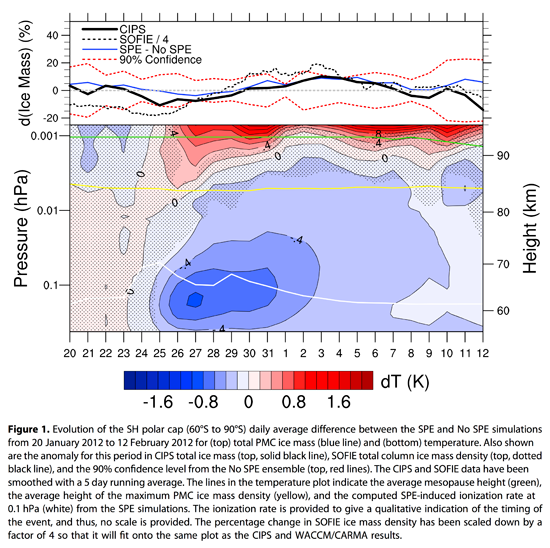|
STATUS:
03.01.2017
Instrument Status:
The AIM spacecraft continues to perform well.
SOFIE:
The SOFIE instrument continues to operate normally, and V1.3 data have been released through February 2017. As the orbit changes, SOFIE has sampled tropical through polar latitudes. With increasingly high orbit beta angles, however, the sun will not set or rise as viewed from the satellite. As a result, SOFIE measurements will not be possible from February 24, 2017 until early October, 2017.
A recent study used AIM SOFIE and CIPS measurements along with WACCM model simulations to determine the impact of the 23–30 January 2012 solar proton event (SPE) on PMCs and mesospheric water vapor [Bardeen et al., 2016]. The results show a small heating and loss of PMC ice mass on 26 January that is consistent with prior results but is not statistically significant. We also find a previously unreported but statistically significant ~10% increase in ice mass and in water vapor in the sublimation area in the model that occurs in the 7 to 14 days following the start of the event. The magnitude of the response to the January 2012 SPE is small compared to other sources of variability like gravity waves and planetary waves. Sensitivity tests, however, indicate that with larger SPEs this time delayed increase in PMC ice mass will be larger, while there is little change in the loss of ice early in the SPE event. The figure below, from Bardeen et al. [2016], compared the observed and modeled changes in PMC ice mass, and shows the temperature perturbation field resulting from the SPE event. The PMC response to SPEs in models is dependent on the gravity wave parameterization, and temperature anomalies from SPEs may be useful in evaluating and tuning gravity wave parameterizations.
Bardeen, C. G., D. R. Marsh, C. H. Jackman, M. E. Hervig, and C. E. Randall (2016), Impact of the January 2012 solar proton event on polar mesospheric clouds, J. Geophys. Res. Atmos., 121, 9165–9173, doi:10.1002/2016JD024820.

|
